Purpose
This test was performed to evaluate the performance of the ACG shaft seal over its lifetime. The seals being tested are Viton V30A.
Apparatus
- Baldor Reliance Industrial Motor CDP3310 (0.25 hp)
- Click PLC controller (made by Automation Direct)
- Leeson Speed Master Motor Control
- Shimpo DT-105A Tachomter
- Telemechanique LC2-D124 reversing connector
- Air compressor
- Parker Pressure Control Gauge
- Teknic 1108908 Pressurization Connector with gasket to fit faceplate
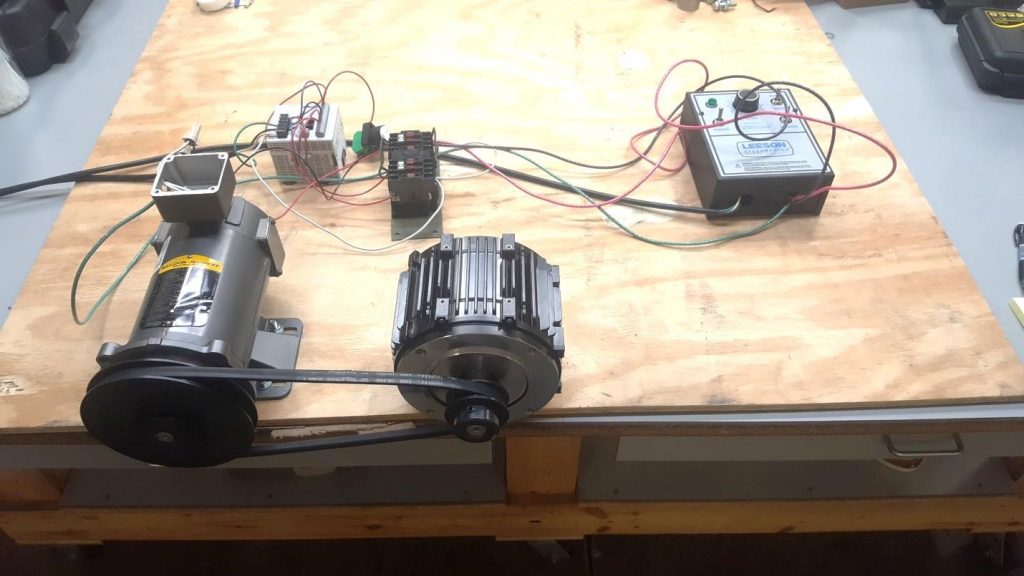
Figure One: Overall Test Apparatus
Procedure
The test was performed using a DC motor to drive the rotation of a shaft with a Viton V30A seal applied to it. The seals were measured and weighed before and after testing. The PLC controller was used to automate the run time and directional changes of the test. The test was performed by the following steps:
- Viton V30A seal is lightly lubricated and applied to shaft. (Shown in Figure 2 below)
- Pulley system is assembled and rotational speed is set utilizing a Leeson Speed Master Motor Control module and a Shimpo DT-105A tachometer. (Rotational speed verified in both clockwise and counter-clockwise directions)
- Test parameters are programmed within the PLC controller in the following sequence:
- Start the motor and bring the shaft rotation up to 2400 RPM clockwise in three seconds
- Run at 2400 RPM clockwise for 90 seconds
- Decelerate to 0 RPM over 3 seconds
- Start motor in reverse direction to bring the shaft rotation up to 2400 RPM counter-clockwise over 3 seconds.
- Run at 2400 rpm counter-clockwise for 90 seconds
- Decelerate to 0 RPM over 3 seconds.
- Repeat steps a through f over a 5 day uninterrupted period
- After the 5 day testing period, the seal was pressurized from the outside of the motor using Teknic 1108908 pressurization connector with a gasket being used to ensure sealing.
- Pressure of 10 psi was applied and held over five minutes. Pressure was observed over the test to check for any losses.
This procedure was performed for two seals. The first seal used an existing counter-face which had been used for past testing. The original counter-face was used to evaluate a Nitrile V28A seal, and was run five days continuously in one direction. This test caused the counter-face to wear down and become rougher, and showed that the Nitrile seal will not function as desired over the lifetime test. The second seal used a newly machined counter-face, giving a more accurate representation of the seals performance.
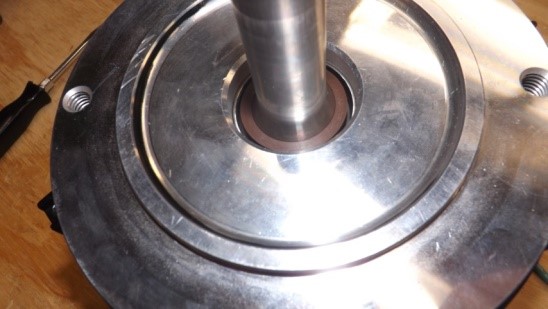
Figure 2: Seal Applied to Shaft
Results
Test 1: Test 1 showed some degradation of the seal lip over the 5 day run time. The counter-face used for Test 1 had been used for V28A Nitrile Seals on continuous multi day testing. These tests were run in a single direction over 5 days, and wore down the counter face. This resulted in the Viton Seal experiencing some degradation. This test passed the 10 psi pressurization with no losses over five minutes.
| Seal Weight Before | Seal Weight After | Seal Free Width Before | Seal Free Width After |
| 3.038 g | 2.991 g | 0.298 in | 0.296 in |
After Five Day Run: No pressure loss at 10 psi applied from outside of seal. Held for 5 minutes
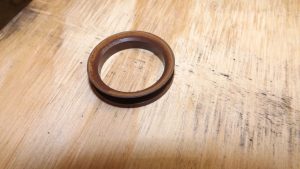
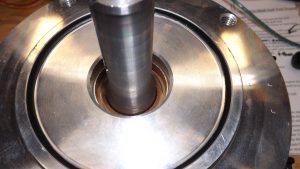
Figure 3: Seal & Counter Face 1
Test 2: Test 2 showed improved results on the newly machined counter-face. There is no degradation of the seal in Test 2. The before and after weight of the seal matched, and there is no residue or dust present in the counter-face.
| Seal Weight Before | Seal Weight After | Seal Free Width Before | Seal Free Width After |
| 3.038 g | 3.038 g | 0.298 in | 0.295 in |
After Five Day Run: No pressure loss at 10 psi applied from outside of seal. Held for 5 minutes
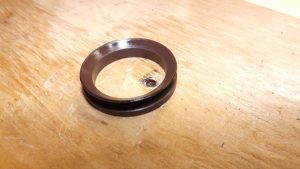
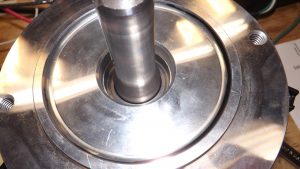
Figure 4: Seal & Counter Face 2
Analysis
The results of Test 2 showed no degradation of the seal, where Test 1 showed some degradation. This is because Test 2 used a newly machined counter-face. Test 1’s counter-face had been used on previous testing with a Nitrile V28A seals. This Nitrile seal was a tighter fit on the shaft, and was run continuously for five days in a single direction on the counter face. This means the counter face was worn down, and therefore exerted more fiction on the V30A seal in Test 1. This rough surface and increased friction resulted in the degradation seen in Test 1.
Test 2’s face plate was used exclusively for the Viton V30A seal, meaning its results are more true the V30A’s performance. The seal was weighed at 3.038 g both before and after the test, showing that the seal did not degrade over its lifetime performance test. There was no residue or dust left in the counter-face.
Both Viton V30A test seals were able to hold the 10 PSI with no losses, showing that the V seal will perform over its lifetime, even if run on a worn down counter-face.
Conclusion
Viton seal V30A has passed its lifetime wear testing. The V seal will not degrade over its life time on a new counter face, and will hold 10 PSI applied from the outside of the motor.
